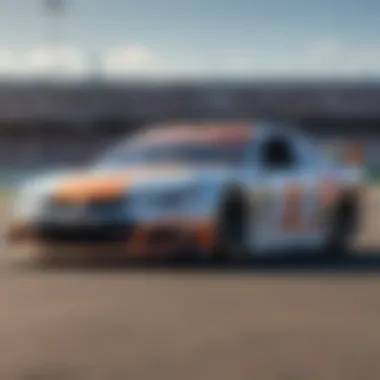NASCAR in Talladega: Racing's Cultural Phenomenon


Intro
NASCAR racing in Talladega is an emblematic experience within the realm of motorsport. The Talladega Superspeedway, known for its extensive history and striking speed, draws racing fans from across the nation. Established in 1969, the track has undergone various transformations, shaping it into a prestigious venue on the NASCAR circuit.
The significance of Talladega goes beyond mere races. It serves as a microcosm of the broader trends affecting the automotive industry and racing culture. Understanding NASCAR in Talladega requires examining its historical roots, the track's unique configurations, and the impact it has on drivers and teams alike.
In this exploration, we will highlight key aspects of Talladega's racing phenomenon. We will delve into team strategies, driver dynamics, as well as the evolving relationship between cutting-edge technology and racing. This analysis provides a clearer picture of why Talladega is more than just another racetrack; it is a pivotal part of American racing heritage.
Prelude to NASCAR in Talladega
NASCAR in Talladega represents a convergence of speed, culture, and community. Understanding this relationship is essential for grasping not only the sport's dynamics but also its broader cultural significance. This introduction explores critical facets of NASCAR, especially within the context of Talladega. It sets the stage for the deep dive into one of racing’s most iconic venues.
Overview of NASCAR
NASCAR, or the National Association for Stock Car Auto Racing, is a prominent motorsport organization in the United States. Founded in 1948, it has evolved into a major sporting league, boasting millions of fans and a complex structure involving teams, sponsors, and events. The sport revolves around stock car racing, where modified production cars race on oval tracks, often reaching incredible speeds.
The appeal of NASCAR lies in its unique blend of tradition and modernity. For many, the cars represent America's automotive legacy, while the races embody the challenges of technology and teamwork. Events often showcase the skills of drivers who must navigate not just the track but also strategies involving fuel management and pit stops. Given its widespread popularity, NASCAR serves not only as a sport but also as an influential cultural phenomenon in the Americas.
The Talladega Superspeedway
The Talladega Superspeedway is a cornerstone of NASCAR racing with its expansive 2.66-mile tri-oval track. Opened in 1969, Talladega has become renowned for its high speeds and thrilling finishes. It hosts some of the circuit’s most anticipated races, including the Talladega 500.
Talladega's distinctive design contributes to its reputation. The track has unique 33-degree banking in the turns, allowing cars to maintain high speeds throughout the race. This engineering marvel attracts fans and drivers alike, turning it into a testing ground for vehicle performance and driver skill. Many drivers express a love-hate relationship with the track, often citing both the exhilaration of racing at high speeds and the risks involved in such scenarios.
Overall, the importance of NASCAR in Talladega cannot be understated. It highlights not just the thrilling aspects of racing but also the collective experience of fans and participants alike.
Historical Context
The historical context of NASCAR in Talladega provides a valuable framework for understanding the significance and evolution of racing in this iconic American venue. Recognizing its foundations helps to illustrate how Talladega Superspeedway has shaped the sport's trajectory. By looking back at its establishment and subsequent developments, one can see how it became a focal point in the NASCAR calendar and how it adjusts to the changing dynamics of auto racing and its fans.
Foundation of the Talladega Superspeedway
Talladega Superspeedway, located in Talladega, Alabama, came into existence in 1969 and marked a transformative moment in NASCAR history. The idea behind the track was groundbreaking. Built with a length of 2.66 miles, it was designed to facilitate high-speed racing on a scale that had never been seen before in the sport. The track's unique configuration, featuring a tri-oval layout, allows for continuous high speeds, leading to some of the most thrilling finishes in NASCAR history.
Imported in a time when the demand for more excitement in auto racing was rising, Talladega quickly gained a reputation. Its first race, held in 1970, drew significant attention and set the stage for future events. The early years saw various adjustments made, from track surface to safety measures, as NASCAR sought to balance speed with the inherent dangers of racing. This evolution speaks to the industry's commitment to ensuring that competition remains both thrilling and as safe as possible.
Evolution of NASCAR in Talladega
Since its inception, NASCAR at Talladega has undergone extensive changes that reflect broader trends in the sport. Initially, the races were characterized by a sense of unpredictability. Drivers often faced challenges, whether from the track itself or from competitors pushing the limits of their vehicles. Over the years, the introduction of technological advances has altered the racing landscape.
With advancements like electronic fuel injection and the implementation of data analytics in race strategies, teams have adapted their approaches significantly. The advent of more sophisticated race cars has also shifted the dynamics. Today's drivers must navigate this intricate environment while maximizing performance through teamwork and strategic insight.
Over the decades, Talladega has seen sociocultural shifts too. The fanbase has grown larger and more diverse, reflecting changing societal norms. Engaging with the audience and enhancing the fan experience have become paramount. From pre-race festivities to post-race celebrations, NASCAR in Talladega embodies not just the sport but also the communal memories created by its fans.
In summary, the historical context of NASCAR in Talladega encompasses the track's founding, its design evolution, shifting fan demographics, and the overall advancement of automotive technology. This context is not merely background; it illustrates the vital role that Talladega plays in the larger narrative of NASCAR and its continual growth as a beloved American pastime.
Track Characteristics
Understanding the Track Characteristics of Talladega Superspeedway is essential for grasping what makes NASCAR racing in this venue unique. The attributes of the track dictate not just the speed at which cars race, but also influence the safety measures in place and how teams strategize during races. Each element of the track contributes to the overall excitement and effectiveness of NASCAR events held here.
Layout and Design
The layout of Talladega Superspeedway plays a pivotal role in the racing dynamics. It features a tri-oval design, which is longer and wider than many tracks in the NASCAR circuit. The main straight stretches nearly 4,000 feet, allowing cars to achieve remarkable speeds. The banking of the turns can reach up to 33 degrees, creating opportunities for drafting.
This unique configuration facilitates close racing, where drafting becomes a vital strategy. As cars follow closely behind each other, they reduce air resistance, increasing their speed. However, this also raises the stakes, as a small error can lead to big accidents. The design not only encourages intense competition but also provides fans with optimal viewing experiences.
Safety Features
Safety is paramount in NASCAR, and Talladega Superspeedway incorporates several advanced safety features. The presence of SAFER barriers is crucial in absorbing impact during collisions. These barriers are designed to minimize injuries to drivers, but like all safety features, they are not foolproof. The layout also includes ample run-off areas, which can help in reducing the speed of cars that go off-track.
Additionally, the track is equipped with modern medical facilities. These ensure that help is swiftly available in case of an emergency. In recent years, NASCAR has enhanced helmet regulations and head-and-neck restraint systems, making sure that equipment and practices continue to evolve with the sport.
Speed and Performance Metrics
Speed is the essence of NASCAR, and examining performance metrics sheds light on what drivers and teams must consider in Talladega. Average lap times can vary significantly during races due to drafting strategies and pit stops. On average, cars can reach speeds over 190 mph during races, but this is not without challenges. Competitive positioning, tire wear, and fuel mileage are essential factors systematically analyzed by teams.


Data analytics has revolutionized how teams approach these metrics. By tracking lap times, and analyzing tire performance, teams make data-driven decisions that affect race strategy. The duration of pit stops can decide the race outcome, showing how every element of speed is intricately connected to performance metrics.
Overall, the characteristics of the track shape not only the race but also the culture of NASCAR in Talladega. Each aspect from layout to safety features contributes to the excitement and strategy of NASCAR racing.
NASCAR Events in Talladega
NASCAR events at Talladega hold a unique place in the landscape of auto racing in the United States. The Superspeedway serves as a stage where speed meets strategy, attracting fans and competitors from all over the nation. This section will explore the significance of these events, including major races and qualifying rounds, highlighting their respective roles and impacts within the NASCAR series.
Major Races
Talladega is home to several major NASCAR races, the most prominent being the NASCAR Cup Series. The GEICO 500 is a key event, drawing massive crowds due to its thrilling nature and high stakes. Races here often see speeds exceeding 200 miles per hour, making them some of the fastest in the NASCAR series. The race's unique format allows for intense, close-quarter racing, enhancing both competition and fan excitement.
Key features of major races at Talladega include:
- Pack Racing: Drivers race in a tightly packed group, which can lead to sudden shifts in positioning and unexpected outcomes.
- Strategic Pit Stops: Teams must carefully plan pit stops to minimize time lost during races that could stretch over four hours.
- Diverse Driver Participation: Talladega attracts both seasoned veterans and up-and-coming drivers, adding to the event's competitive spirit.
These races have historical significance, witnessing numerous memorable moments that fans often recount. The unpredictability of outcomes in Talladega races contributes to their reputation, making them must-watch events in the NASCAR calendar.
Qualifying Rounds
Qualifying rounds at Talladega are an essential aspect of the event schedule, determining the starting grid for the major races. Unlike traditional qualifying sessions seen in other racing formats, Talladega's superspeedway layout allows drivers to make multiple attempts, bringing unique challenges to the fore.
Several factors come into play during these qualifying rounds:
- Aerodynamics: Drivers often work together in packs to enhance their chances, creating a fine balance between competition and cooperation.
- Timing Strategy: The ability to time laps precisely can greatly influence starting positions, as drivers consider traffic and track conditions.
- Practice Sessions: Before qualifying, teams hold practice rounds to fine-tune setups and gauge their speed against competitors.
The outcomes of these rounds profoundly affect race strategies. A strong qualifying position can lead to better chances of success in the race itself. Understanding the dynamics of qualifying at Talladega enhances the overall perception of the NASCAR ecosystem as it demonstrates the different layers of competition within this exhilarating sport.
"Talladega is not just a track; it's a strategic battleground where every decision counts."
Driving Dynamics
Driving dynamics in NASCAR, especially at Talladega, is a critical aspect that influences the outcome of races. The high-speed environment presents unique challenges and requires adaptability from drivers. Understanding these dynamics can unveil insights into performance and strategy.
Driver Profiles
Every driver possesses unique skills and experiences that shape their approach to racing. For instance, Dale Earnhardt Jr. is known for his aggressive driving style, while Jeff Gordon displayed precision and consistency. The psychological factors also play a substantial role. A seasoned driver like Jimmie Johnson thrives under pressure, allowing him to navigate tight packs and make split-second decisions effectively. Each driver brings a different resilience and competitive edge. A driver’s ability to read the track conditions and competitor movements can significantly impact results.
Additionally, the physical demands require endurance and sharp reflexes. Long race durations test not only skill but also stamina. The driver's connection with the car, emotional control, and teamwork with spotters further amplify their performance.
Team Strategies
Team dynamics in NASCAR often define the trajectory of a racing season. Strategically, teams can utilize various approaches to gain an advantage during races at Talladega. Understanding the aerodynamics at play on this high-banked track is essential. For instance, teams often focus on drafting techniques to improve speed and fuel efficiency by sticking close to other cars.
Several strategies are considered, including:
- Pit Stop Timing: Teams must optimize pit stops for fuel and tire changes. Timing can be crucial during caution flags and can result in gaining or losing several positions on the track.
- Collaboration among Drivers: It is common for drivers in the same team to work together during the race, coordinating efforts for maximum advantage.
- Adjustments on Race Day: Teams often tailor their strategies based on weather and track conditions. Preparing for unexpected changes can lead to successful adaptations.
Successful teams, like Stewart-Haas Racing, exemplify strategic planning and execution. They consistently analyze data to optimize performance and define their race day strategies competently.
"Teamwork and communication are essential in NASCAR. Every second counts, and decisions made during the race can impact everything."
Fan Engagement and Culture
Fan engagement and culture are cornerstones of NASCAR racing, particularly in places like Talladega. The impact of devoted fandom extends well beyond the racetrack, influencing everything from event logistics to the overall atmosphere of the race weekend. Engaging fans not only deepens their connection to the sport but also cultivates a sense of community among them. This culture is vital for NASCAR’s longevity, as it aids in retaining existing fans while attracting new ones.
Demographics of NASCAR Fans
Understanding the demographics of NASCAR fans reveals much about why Talladega remains an essential venue. The audience is notably diverse, spanning various ages, backgrounds, and interests. Historically, NASCAR has drawn a strong following from rural and suburban areas, particularly in the Southeastern United States.
Amplifying the importance of demographics, studies show that fans tend to be predominantly male but increasingly include females, particularly in recent years. The age range, while anchored in middle-aged fans, has seen a rise in younger viewers thanks to efforts in modernizing the sport and improving engagement through digital platforms. This mix creates a vibrant fan base, each group bringing their own values and expectations.
Some key statistics include:
- Age: Many fans fall between 25 and 54.
- Gender: The demographic shift sees 40% of fans being female.
- Location: A significant portion of fans resides in Southern states, with Alabama being a hotspot during race weekends.


This diverse demographic influences NASCAR's marketing strategies and shapes the experiences tailored for fans attending events at Talladega.
Event Experience
The event experience at Talladega is uniquely crafted to cater to its audience. Factors like pre-race festivities, fan interactions, and overall accessibility combine to create an unforgettable atmosphere for attendees. The sense of excitement and joy at the racetrack resonates through each event.
Several components contribute to this dynamic experience:
- Pre-Race Activities: Tailgating, concerts, and meet-and-greet sessions with drivers enhance engagement before the race starts.
- Fan Zones: Designated areas allow fans to interact, take pictures, and participate in activities related to the races.
- Merchandise: Various stalls and vendor offerings provide fans the chance to purchase memorabilia that connects them to the sport.
- Pit Access: Giving fans limited access to the pit area creates a deeper level of excitement and exclusivity.
"The electric atmosphere of Talladega transforms during race weekends, making it a memorable experience that fans cherish greatly."
These elements are not just about entertainment; they build a culture where fans feel part of something bigger. The emotional connection fostered during these events fuels loyalty to the sport. In essence, the experience makes NASCAR not merely a series of races, but a community event that ignites passion and camaraderie among its fans.
Technological Advances
The importance of technological advances in NASCAR cannot be overstated. As the sport has evolved, so too have the tools and techniques that teams utilize. Innovations in technology shape both the racing itself and the way fans engage with it. Modern racing is as much about strategy and data as it is about speed and skill. This section focuses on the key areas where technology influences NASCAR, particularly in Talladega.
Data Analytics in Racing
Data analytics has changed the landscape of racing significantly. Teams can now collect and analyze vast amounts of data during practice sessions, qualifying, and races. Sensors on vehicles gather information on speed, tire wear, fuel usage, and other critical metrics. This data allows teams to make informed decisions on strategy, such as when to pit or whether to adjust tire pressures.
Key aspects of data analytics in racing include:
- Performance Monitoring: Continuous data collection helps teams monitor car performance in real time.
- Predictive Analytics: Understanding patterns from previous races helps predict outcomes, which can inform race strategy.
- Enhanced Communication: Data-sharing tools improve communication between drivers and pit crews, contributing to swift decision-making.
Data analytics enables teams to fine-tune their cars to enhance performance. As a result, it creates a highly competitive environment where marginal gains can make the difference between winning and losing.
Vehicle Performance Enhancements
Vehicle performance enhancements in NASCAR are critical for maximizing speed and safety. Innovations in engineering lead to advancements in aerodynamics, powertrain developments, and material technology. These enhancements can be the distinguishing factor during the race.
Important areas of focus in vehicle performance include:
- Aerodynamics: Improvements in body design reduce drag and increase downforce, providing better handling at high speeds.
- Engine Optimization: Modern engines are more powerful and efficient, offering better acceleration and fuel economy.
- Suspension Systems: Advanced suspension technology allows for improved handling on the unique Talladega track layout.
Advances in vehicle performance are essential not just for winning races but also for maintaining driver safety in the high-speed environment of Talladega.
Through these technological innovations, NASCAR continues to evolve, ensuring that both teams and fans experience a thrilling and safe racing environment.
Economic Impact
The significance of NASCAR in Talladega extends beyond the thrill of the race. It plays a vital role in shaping the economic landscape of the region. This section will explore how the events at Talladega Superspeedway influence not only the local economy but also contribute to job creation and sponsorship dynamics. The impact is multi-faceted, affecting a range of sectors including hospitality, retail, and local services.
Local Economy and Job Creation
NASCAR events attract large crowds to Talladega, which significantly boosts local businesses. Hotels, restaurants, and shops experience increased foot traffic during race weekends. According to various studies, a single event can generate millions in revenue for the area. This surge helps sustain small businesses that depend heavily on tourism related to racing.
Furthermore, jobs are created both directly and indirectly. Positions range from event staff, security personnel, and maintenance crews to roles within hospitality services. Local economies benefit from this influx of jobs, particularly in the off-season when other industries may languish.
- Job types created include:
- Event coordination and planning
- Ground and facility maintenance
- Hospitality and food service
- Retail and merchandise sales
The ripple effects can be substantial. Local vendors, service providers, and suppliers all find new opportunities tied to the racing calendar.
Sponsorship and Revenue Streams
Sponsorship plays a crucial role in sustaining the financial health of NASCAR in Talladega. Major brands invest heavily to promote their products and services during races, knowing they can reach a vast audience. Companies like GEICO and Coca-Cola are notable sponsors that enhance the overall experience while benefiting the local economy as well.
The money comes not just from ticket sales but from the extensive sponsorship deals that teams and events secure. These partnerships generate significant revenue streams. They contribute to race prize funds and financing for improvements to the Superspeedway itself.
- Key revenue sources include:
- Title sponsorships of events and series
- Branding on vehicles and uniforms
- Promotional activities before and during races


The integration of sponsorship into the NASCAR experience creates a symbiotic relationship. Brands gain visibility, and the local economy reaps benefits from increased spending.
"NASCAR events are not just races; they are economic engines for their communities. The influx of visitors and associated spending can revitalize a local economy in a short time."
In summary, the economic impact of NASCAR in Talladega is significant. It highlights the intertwining of sport and commerce in a way that benefits the local community. As Talladega continues to host major racing events, its role as a catalyst for economic development remains evident.
Challenges Facing NASCAR
In the realm of motorsport, NASCAR is a giant, especially at venues like Talladega. However, various challenges confront the sport. Addressing these challenges is crucial for the sustainability and growth of NASCAR. This section delves into two primary areas: safety concerns and environmental considerations. Both of these topics are intertwined and hold significant implications not just for drivers and crew members, but also fans and the broader community.
Safety Concerns
Safety in NASCAR has evolved over decades but remains a critical issue. High-speed racing inherently poses significant risks. Each race at Talladega can reach speeds over 200 miles per hour. The high stakes increase the potential for accidents, which can lead to severe injuries or fatalities.
NASCAR has made considerable progress in safety initiatives. The introduction of the SAFER barrier technology is one of the most impactful changes. These barriers absorb energy during crashes, helping to protect drivers. Also, specialized helmets and suits are now standard.
Despite these advancements, the sport still faces criticism. Recent incidents have sparked debates about whether the existing safety protocols are sufficient. Many fans and experts urge for continuous improvements and innovations in safety measures to adapt to the high-speed nature of racing. More rigorous driver training could also minimize risks. NASCAR must remain vigilant and proactive in prioritizing competitor safety.
Environmental Considerations
As society becomes more environmentally conscious, NASCAR is also reevaluating its practices. The sport's reliance on gasoline and the carbon footprint of large events pose real questions about sustainability. Talladega, with its massive crowds and high energy consumption, exemplifies these challenges.
NASCAR has initiated some changes. The series has been exploring alternative fuel sources, such as biofuels, to lessen its environmental impact. Furthermore, efforts to promote sustainability at events have begun. Strategies include recycling programs and more efficient energy use during races.
However, criticism remains regarding the pace of these developments. The shift to genuinely sustainable practices requires substantial investment and commitment from all stakeholders. Engaging fans in this journey could foster a more eco-conscious racing culture and establish NASCAR as a leader in sustainable sports.
In summary, both safety and environmental issues constitute pressing challenges for NASCAR. As the sport navigates growth and modernization, it must balance thrilling competition with responsibility to its participants and the environment.
Future of NASCAR in Talladega
The future of NASCAR racing in Talladega represents a critical area for understanding how this sport can evolve while maintaining its core identity. Talladega Superspeedway is not just a venue; it embodies the spirit of NASCAR itself. As the industry adapts to changes in technology, audience preferences, and regulatory frameworks, the future will likely see profound changes that are essential for the sport's survival and growth.
Emerging Trends
Emerging trends indicate a shift toward a more diverse and tech-driven NASCAR experience. One of the most promising trends is increased engagement with younger audiences. High-profile initiatives to promote inclusivity are reshaping the fanbase. This includes outreach and partnerships with educational institutions, fostering grassroots racing and encouraging young drivers from various backgrounds to participate.
The integration of technology is apparent in various forms. Enhanced viewing experiences through virtual and augmented reality create new opportunities for watching races. Fans want interactive content, so developments in app technology will support real-time race data, allowing spectators to feel closer to the action.
Notable Trends:
- Increased representation across demographic lines.
- Growth in technology use during races, like drone coverage.
- A focus on sustainability, including plans to reduce carbon footprints.
Innovation and Adaptation
Innovation and adaptation are vital to the future of NASCAR in Talladega. The racing teams must continuously evolve to enhance vehicle performance and streamline operations. Data analytics is at the forefront of this shift, with teams employing sophisticated algorithms to analyze race data. This impacts everything from tire strategy to pit stop efficiency.
Moreover, new regulations require adapting vehicles for safety while improving speed. NASCAR has initiated steps forward in developing electric racing vehicles. The future might see the introduction of hybrid models to balance performance with environmental considerations, attracting new fans and partners who prioritize sustainability.
In summary, the future of NASCAR in Talladega involves embracing technological evolution and societal changes. The incorporation of emerging trends and continuous innovation will position Talladega as a leader in the racing world, ensuring that the sport not only survives but thrives in changing times.
"The adaptations we make today will determine how NASCAR is perceived a decade from now. In Talladega, those changes are happening at breakneck speed." - NASCAR expert
Ultimately, the balance of tradition and forward-thinking strategies will define the racing culture in Talladega, calling on teams, sponsors, and fans to collaborate in creating a more vibrant future.
Epilogue: The Legacy of NASCAR in Talladega
The significance of NASCAR in Talladega extends far beyond its thrilling races. It embodies a cultural phenomenon that reflects the deep-rooted passions of fans, drivers, and communities. This conclusion emphasizes the multifaceted legacy of racing in Talladega, addressing the strengths, advancements, and struggles of this iconic sport. Through key elements such as historical context, technological advancements, and economic implications, it is apparent that Talladega serves not only as a racetrack but as a vital pillar in the world of NASCAR.
Reflections on Its Impact
Talladega Superspeedway has undoubtedly made significant contributions to the realm of NASCAR. The unique design of the track challenges drivers while encouraging them to push the limits of their vehicles. These high-speed events have drawn large crowds, fostering a vibrant local community around the sport.
The economic impact is clear. Thousands flock to Talladega for races, significantly boosting local businesses, hotels, and restaurants. The annual influx of visitors underscores the importance of this raceway as a source of livelihood for many in the region. The emotional connection of fans cannot be overlooked; it transcends simple entertainment, creating a shared identity among diverse groups of people.
Looking Ahead
The future of NASCAR in Talladega looks promising but also faces challenges. As the sport evolves, embracing new technologies becomes essential. Vehicle performance enhancements and data analytics improve not only the races but also engage fans through deeper insights. This technological adaptation is vital for capturing a younger audience while maintaining the loyalty of established fans.
Moreover, environmental considerations are increasingly pertinent. The push for sustainable practices within racing is not merely beneficial but essential for the sport’s longevity. Adapting to these challenges will define how NASCAR in Talladega develops in coming years.
In summary, NASCAR’s legacy in Talladega is built on a rich history, a passionate community, and a commitment to progress. The balance between tradition and innovation will shape its trajectory, ensuring that Talladega remains a cornerstone of American motorsports.







